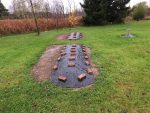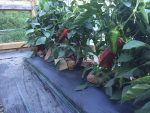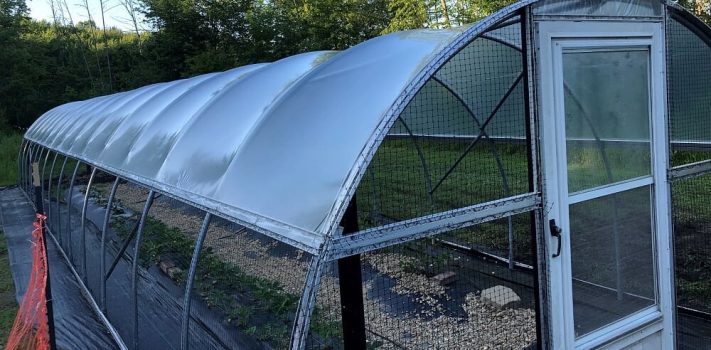(Continued from Part 1. This concludes the article.)
For covering all of the crop rows, we use a black on white 1 mil UV stabilized poly film. This versatile material must be replaced every year after the grow season ends. Depending on which crop is being planted, we roll it out either white up or black up. The white, best for greens and brassicas, has a cooling effect on the soil by reflecting sunlight. The black warms the soil by absorbing sunlight and is used for the majority of crops. When used in the hoop house, drip tape would be installed first on the row before the film. Using this film has several benefits besides weed control including moisture retention, erosion control, and temperature regulation.
Another unexpected benefit is that using the film prevents the plant leaves from touching the soil. Plants stay much cleaner and less at risk for soil borne disease because of that barrier. Anyone who’s cleaned garden lettuce will appreciate that. The film is easily cut with a small putty knife when it’s time to plant the soil blocks or direct seed. There are implements used to apply this film in commercial applications, but we do it easily by hand. Once the film is down, we border it with the mulch cloth to complete the install. This method serves to channel rainwater to the base of the raised rows which wicks up into the roots.
Using these weed control methods will eliminate all weeding chores for your row crops and trees. The big exception is mound grown crops like raspberries, asparagus, and potatoes. Our asparagus is finally doing great, but it requires frequent weeding due to the exposed soil requirement. A ground covering tip we’ve learned is that having loose bricks (like those left over from a chimney repair) laying around is very helpful when installing the cover material.
Plasticulture technique: pest control
 Most growers know that preventing damage by insects and animals is a constant battle. Your locale will dictate what type of pests pose a threat to your crops. We deal mostly with coons, deer, groundhogs, hares, voles, birds, and all manner of bugs. For the birds and mammals, we’ve eliminated the threat using 5’ poly netting (mentioned above) to create fences and walls. These fences are easily assembled and disassembled, and the netting is reusable. The simplicity of using netting, zip ties, and t-posts for fencing can’t be beat. The netting can also be installed into the wirelock as walls on the hoop houses making seasonal adjustments simple. We’ve even developed a simple gate system for the netting using s-hooks and screw eyes. The 1” spacing on the netting prevents birds from entering while allowing access for pollinators. In addition to garden use, it’s used to contain the chickens as well as keeping out the predators. While it can be chewed through, that has not been an issue for us. I would not recommend this fencing method for large livestock of any kind. A pest control tip we’ve learned is to have a few good barn cats- damage from mice, voles, and chipmunks is a thing of the past.
Most growers know that preventing damage by insects and animals is a constant battle. Your locale will dictate what type of pests pose a threat to your crops. We deal mostly with coons, deer, groundhogs, hares, voles, birds, and all manner of bugs. For the birds and mammals, we’ve eliminated the threat using 5’ poly netting (mentioned above) to create fences and walls. These fences are easily assembled and disassembled, and the netting is reusable. The simplicity of using netting, zip ties, and t-posts for fencing can’t be beat. The netting can also be installed into the wirelock as walls on the hoop houses making seasonal adjustments simple. We’ve even developed a simple gate system for the netting using s-hooks and screw eyes. The 1” spacing on the netting prevents birds from entering while allowing access for pollinators. In addition to garden use, it’s used to contain the chickens as well as keeping out the predators. While it can be chewed through, that has not been an issue for us. I would not recommend this fencing method for large livestock of any kind. A pest control tip we’ve learned is to have a few good barn cats- damage from mice, voles, and chipmunks is a thing of the past.
 I’ve come to understand that if a crop is healthy, properly watered, and has the correct mineral/nutrient ratios, it will be much less susceptible to disease and pest damage. The idea is that a healthy plant will generate its own resistance to many of nature’s assaults- a remarkable characteristic. However, providing perfect growing conditions to achieve this balance is rarely accomplished. We’ve found no pest to be more damaging in our garden than the cabbage moth worm. Due to the utter destruction caused by this creature, floating crop cover (row cover) has found a permanent place in our arsenal. This highly versatile, lightweight woven poly fabric lets air, water, and sun in while keeping the flying insects out.
I’ve come to understand that if a crop is healthy, properly watered, and has the correct mineral/nutrient ratios, it will be much less susceptible to disease and pest damage. The idea is that a healthy plant will generate its own resistance to many of nature’s assaults- a remarkable characteristic. However, providing perfect growing conditions to achieve this balance is rarely accomplished. We’ve found no pest to be more damaging in our garden than the cabbage moth worm. Due to the utter destruction caused by this creature, floating crop cover (row cover) has found a permanent place in our arsenal. This highly versatile, lightweight woven poly fabric lets air, water, and sun in while keeping the flying insects out.
I use the same PVC conduit that brought power to the hoop houses to make mini hoops to cover the brassica rows. Rows of 2’ long rebar are installed in the ground on either side of the bed spaced 3’-4’ apart, then the conduit is inserted on either end making a curved bow. Add a purlin at the top of the hoop, then drape the row cover over top and secure with bricks to pull it tight. This simple design has eliminated the moth worm problem entirely. Row cover has many uses including frost protection, wind/rain protection for transplants, hanging net for trellised melons, and even as a rope to tie up sagging fruit trees and bushes. It’s reusable, though tears easily and needs to be kept dry.
Plasticulture technique: miscellaneous
By far, the most used and most useful plastic product at our homestead is zip ties. We lay them in deep. I won’t list all the uses, but they are used almost every day when working in the garden. I’m sure that some readers have more creative uses for zip ties than I do, but I believe they are a must have item for any homesteader or preparedness minded individual. In fact, I figure that someone could write an entire post here at Survival Blog about useful ideas for zip ties. We typically buy the UV-rated black ones due to the durability outdoors. They are available in many sizes, will last on the shelf for years, are lightweight, versatile, and affordable. There’s no good reason not to have a few bags on hand.
Food storage can be a challenge for homesteaders. We’ve found plastic vented produce storage bins to be a huge help. These bins can nest for storage when not in use, or stack when full of produce. They’re vented to allow for air flow which minimizes moisture on your stored produce. We use them to store things like onions, garlic, and potatoes over winter. Other plastic food storage means include Tupperware containers and Ziplock freezer bags.
Another useful plastic product is vine clips. These are used to attach the branches of your tomato, pepper, cucumber, melon, and any other viney crop to a trellis or cage. They break easily so will need to be replaced often. We use mason string line tied to the center ridge pipe in the hoop house and the vine clips to make trellises.
A must have in any kitchen is the plastic salad spinner. Whether cleaning homegrown or store-bought lettuce and greens, there is no substitute for a good salad spinner. Large commercial grade salad spinners are also available for farm or restaurant applications. These heavy-duty units have a large capacity and can handle veggies as well as greens.
As mentioned above, food grade poly drums are useful for water storage. They can be found on Craigslist or at your local hardware store. It’s important to choose drums that have not been used to store chemicals. IBC totes are similar but have a metal cage and larger capacity. Both are useful to integrate into your irrigation or emergency water storage systems. Some people use large plastic water drums or tubs to heat their greenhouses by means of the “heat sink” effect. They can also be used in maple sugar production. Speaking of maple sugar, many maple producers are now increasing efficiency by using plastic sap lines and gravity for harvesting.
During winter when the garden is mostly dormant, we need to keep the wood stoves fed. Old recycle bins and USPS mail carrier trays are two plastic products that make wood chores much easier. We fill these bins in the wood shed, then store them in plastic deck boxes on the patio. By bringing in one or two bins at a time to feed the stoves, the mess and dust from the firewood is mostly contained. Also, the bins are a perfect size to keep the loads of wood at a manageable weight.
Other useful plastic products on the homestead include heavy duty contractor trash bags, 5 gallon buckets, pump sprayers, Pelican cases, plastic ammo/dry boxes, storage totes, and various types of plastic sheeting. I’ve found several novel uses for PVC pipe including feeders for the chickens. I’ve made fly traps from old plastic vinegar bottles. I usually save poly fabric feed sacks for any number of future uses including garbage bags and sandbags. PVC trim and polycarbonate panels are other handy plastic products that are useful for exterior projects. Plastic bus tubs are useful for harvesting and cleaning produce.
But plastic destroys the planet
We’ve all seen the images on the internet of giant floating islands of plastic waste in the Pacific Ocean and been compelled by pony tailed teenagers to embrace our collective guilt (how dare you!). Pollution from plastic waste in oceans and waterways is a real problem that needs addressed. A recent study out of Germany shows that up to 95% of plastic pollution load in the world’s oceans originates in Asia and Africa. The main reason for this statistic is that developed Western nations do not use rivers and waterways for disposal of trash- we use landfills. It’s incumbent on all of us to not only avoid littering, but also reduce our garbage output using the simple- reduce, reuse, recycle.
Some may argue that the manufacturing process of the plastic products I’ve described here contributes to air pollution and “global warming”. They might be right- however, I’d ask what are the effects of industrial scale agriculture? Between the bulk transport of seed and pesticides/herbicides, running of large tractors during cultivation and harvest, transport of finished product, and refrigeration needed to keep it fresh- how much fossil fuel did it take for that tomato to make it to your plate? What about the single use packaging? Besides being extremely unhealthy to ingest, what are the environmental impacts of the overuse of petrochemical agricultural products like glyphosate? What threats to the Earth’s biosphere do GMOs pose? Will future generations be able to cultivate America’s breadbasket when our current farming methods are stripping bare the once nutrient rich and fertile soil?
Closing thoughts
Plasticulture should not be viewed as a truly sustainable growing method such as permaculture. I view it as more of a complimentary method to be used in a wide range of homesteading initiatives. We have many permanent edible plants in our landscape that can thrive without the use of any plasticulture techniques. We’re also developing plans to integrate permaculture plantings into the meadow at the edge of our yard. The use of plastic simply makes things easier and speeds up our quest to maximize yields. Building a 10+ year supply of the plasticulture products needed to produce food in excess of my family’s needs when SHTF brings a welcomed measure of insurance. If these products become scarce in the future, our supply along with our knowledge and abilities will become a highly valued commodity.
As we enter a new grand solar minimum and see a weakening of the Earth’s magnetosphere, I recognize that climate patterns will indeed change. Shifting jet streams and meridional flows will result in shifting agricultural grow zones and more extreme weather anomalies. The effects on global crop output will hurt the third world particularly hard, and we in the West will feel it most in the pocketbook. Adapting growing strategies will become an important trend in the coming decades. Why not start now?
If individuals, families, and communities can embrace more sustainable and decentralized growing practices like plasticulture, we will not only become healthier, but we can start to reduce our dependence on the outdated and destructive model of industrial food production. I learned at an early age the importance of responsible stewardship of the land because our tenancy is only temporary. Plasticulture not only helps me achieve a higher level of food sovereignty for my family, but it provides an opportunity to responsibly and efficiently connect to the land in a truly meaningful way.











Well done. And yes, it is a bit of a conundrum trying to weigh the environmental impacts and costs of plastic production, use and disposal against the benefits achieved by using it. I try to use plastic when it’s most beneficial and re-use plastic items whenever possible. Thus I collect used plastic 2 and 5 gallon pails from the bakery whenever possible instead of buying new ones. I used good(expensive) UV resistant greenhouse plastic that lasted for a number of years and patched holes with repair tape as needed and avoided the cheaper plastic sheeting which would break down in the sun within a year.
It sounds like you’ve done a similar cost/benefit analysis and are a thoughtful user of plastic when it’s most beneficial.
You’re right Ani- cost includes both dollars spent and time/labor. Depending on your labor cost it might be wiser to spend dollars on infrastructure to reduce labor.
We too have found that non UV greenhouse plastic doesn’t last more than a season.
Thanks for reading!
I enjoyed your article very much and learned several things. While there appears to be an up-front cost, the materials would last a long time if cared for properly.
We reuse our plastic items over and over; I am still using 12 year old tarps and buckets and milk crates. When we can squeeze another use out of it, we either put it in the bone yard, burn it or chip it, depending on size. As homesteaders, we don’t produce enough bad off-product to even measure. China, Russia, India, and Africa produce the majority of bad environmental effects and I would love to send the environmental groups to those countries where they might do some good.
Glad you took something away from it Animal. The motivation behind the article was to share our experiences hoping others could avoid some of our mistakes.
HP,
I’m curious, what was your objection to using UV resistant PVC pipe to construct the framework for your greenhouses?
Good question Charles. The way we build our greenhouses, the bows are the structure that everything attaches to. The wirelock, endwalls, purlins, and other bracing are all attached to the bows with self tapping framing screws. This provides a durable structure that lasts for many years. PVC framing would not give us the same lasting performance of metal. With the snow loads we get up here, strength and durability are important. PVC does work well for the mini row cover hoops as detailed above. Though even the UV stable conduit tends to break down after 4-5 years.
Thanks for reading!
In FL, the UV resistant PVC electrical conduit seems to start to deteriorate after about three years. I have a dome made from 1 in. conduit that was up for a few years. I need to paint the struts and hubs before I reassemble it. Hopefully, that will extend the useful life of the PVC.
I would recommend that you paint all outdoor PVC structures, regardless of stated UV resistance.
I think plastic and other petroleum-based products are responsible for the cancer problems our country has. You better stock up before SHTF. Consider buying something more sturdy to cover your greenhouse going into the future to help deal with the solar minimum and extreme weather (hail) coming our way.
What a comprehensive article! Great descriptions of the process, including the pitfalls. I have first-hand experience with the benefits of this method: lots and lots of high quality produce (may not be able to close the frig door from time to time!). However, I’m left with questions and a desire for more info with lots of detailed illustrations. Have you thought of writing a book on this? I would buy it. Just an idea…